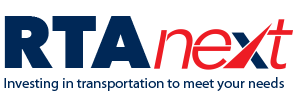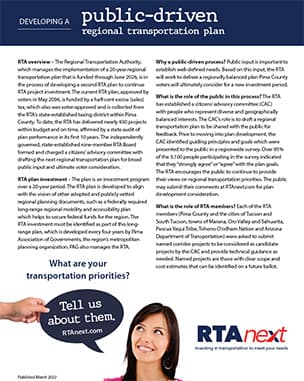
RTA Next Plan Development Update
A message from Farhad Moghimi, RTA Executive Director: Where we stand with RTA Next

The Regional Transportation Authority’s Citizens Advisory Committee will continue its efforts to prepare a $2.34 billion, 20-year draft plan for RTA Board review by early December.
The board extended the draft plan delivery deadline from July 1 to Dec. 6 to allow the CAC more time to review updated project cost estimates and finalize a recommended draft plan in collaboration with the RTA Technical Management Committee.
The CAC will be finalizing a list of named roadway corridors with multimodal enhancements, as well as weighing in on funding split recommendations for other plan elements that include transit, safety, active transportation and environmental improvements.
“We’ve had a lot of moving parts in this plan development process, but we are getting close to the finish line,” said RTA CAC Chair Tom McGovern. “The RTA Board has given us clear direction and a new deadline. This will allow plenty of time for the public to give their feedback to the RTA as well.”
Next steps in the plan development process include:
- Dec. 6 – deadline for RTA Next draft plan
- Dec. 7 – RTA Board initial review of recommended draft plan
- January-June 2024 – RTA public outreach regionwide for review of and feedback on draft plan
- Summer/Fall 2024 – RTA Board reviews public feedback and finalizes plan
- Fall 2024/Winter 2025 – RTA Board requests plan and sales tax initiatives be placed on Pima County ballot and RTA continues public education of plan contents
- May 2025 – RTA Election
Other plan development background and insights:
- At its July 27 meeting, the RTA Board unanimously reaffirmed the budget for the next RTA plan at $2.34 billion, which is based on a 20-year extension of the current RTA half-cent transaction privilege or sales tax, and pessimistic tax revenue estimates prepared by the University of Arizona Eller College of Management.
- By setting the budget with a pessimistic estimate, the RTA can better cushion future economic swings that impact revenue flow. In turn, this will help prevent the region from tapping into other regionally dedicated state and federal transportation funds to supplement RTA revenues as it needed to do following the Great Recession to deliver the 2006 plan projects as promised.
- The current RTA plan and half-cent sales tax are effective through June 2026. Without a new plan and tax extension, the region stands to lose the $2.34 billion regional transportation investment to improve transportation reliability, accessibility and safety, as well as improve environmental and economic vitality as the region continues to grow.
- The region continues to grow 1% annually, although slower than before the Great Recession. However, the region has a deficit of approximately $17 billion to meet regional transportation needs. The RTA’s $2.34 billion infusion is not enough to close the funding gap but will continue to improve the region’s transportation infrastructure to ensure we have a quality system that supports business development, workforce connections, safer streets, and multimodal options that meet the needs of all system users over time.
- The RTA currently provides the largest amount of annual transportation funding for the region with an annual average of more than $110 million, which compares to a combined $51 million of state and federal transportation dollars for the region.
- The RTA provides a flexible funding source, with no federal strings attached. This allows the voters to help decide where RTA dollars should be spent to address the region’s highest transportation priorities.
- The 2006 voter-approved RTA plan has invested more than $1.6 billion to date on regional transportation improvements. This has supported thousands of jobs and has led to major economic development improvement projects, including new motels, medical facilities, shopping centers, restaurants and more along key transportation corridors.
- The RTA invests $30 million annually in regional transit services, including expanded evening and weekend Sun Tran services, as well as neighborhood Sun Shuttle services. Without a new plan and tax continuation, local jurisdictions will have to use their limited general funds to maintain the current level of transit services.
- The RTA Board has pledged delivery of all 35 corridor projects in the 2006 plan and has had two successful state performance audits (at 10 years and 15 years) of the RTA’s project and financial management to ensure your dollars are used appropriately as required by state laws and RTA Board policies.
- The RTA half-cent sales tax is collected within Pima County, the boundary of the RTA’s taxing district. Tourists and visitors also pay the tax to support improvements to our regional transportation system. No matter where you spend your money in the region, your tax dollars support the region overall vs. any one jurisdiction with your investment to improve our overall quality of life.
To view the currently proposed draft framework of the next RTA plan, please visit RTANext.com for information or to follow the process.

